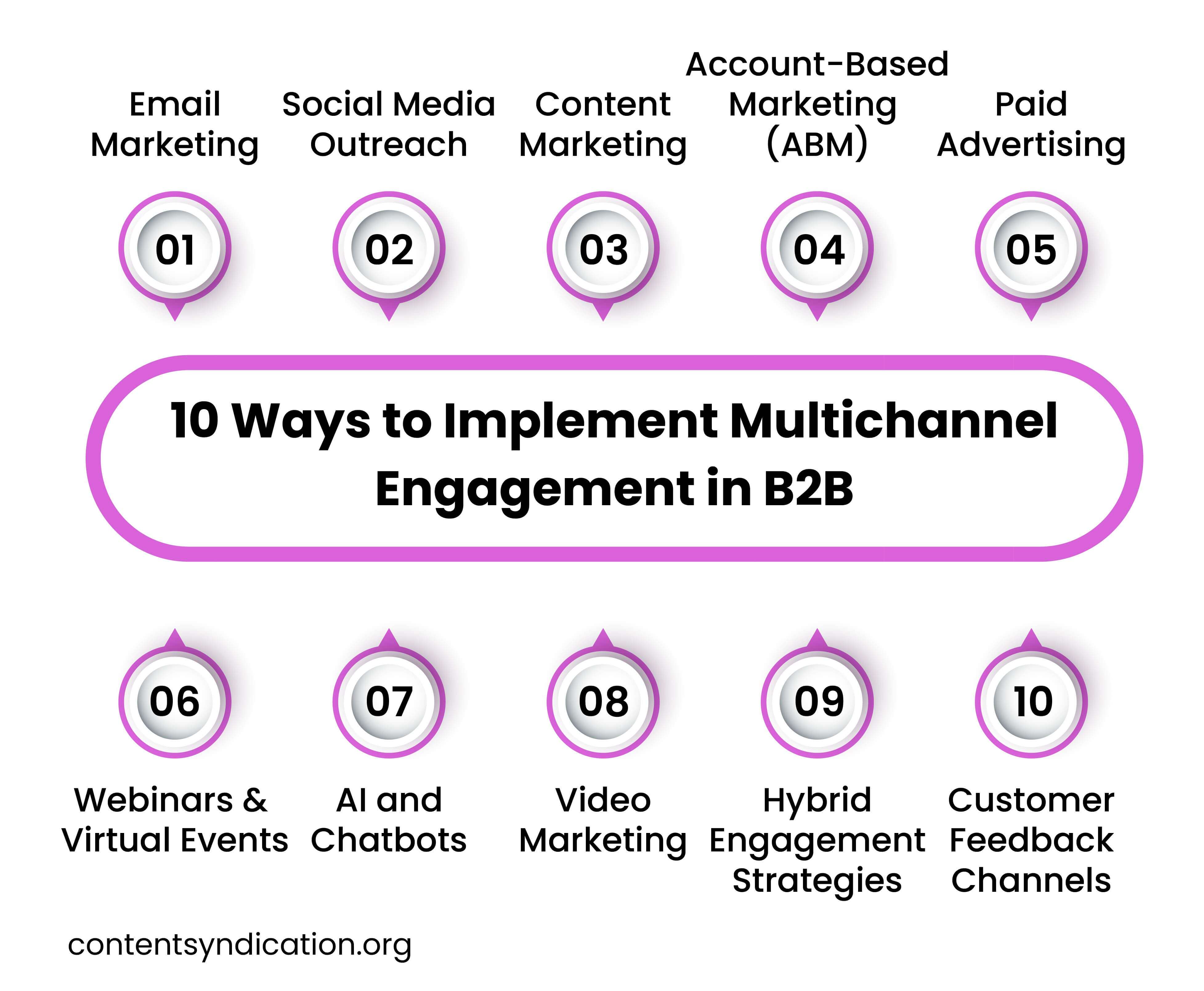Everyone agrees: multichannel marketing is a good idea. But few know how to truly master it.
Your audience is everywhere—on social media, reading emails, attending webinars, or networking at trade shows. The more touchpoints you create (without becoming intrusive), the better your chances of building meaningful connections.
But what’s making multichannel marketing so impactful? Let’s dive into its key benefits and why it deserves a prime spot in your B2B marketing strategy.
What is Multi-Channel Content Syndication?
Multi-channel content syndication involves sharing marketing content—such as blogs, videos, whitepapers, and eBooks—across multiple platforms to reach a broader audience. Buyer’s today are no longer restricted to one source of information. They’re active on LinkedIn, follow email links, and consume industry-specific resources.
By adopting this approach, you can connect with diverse audiences by distributing content where prospects spend their time. It addresses the challenge of fragmented buyer behavior while creating a unified brand experience across platforms.

How Multi-Channel Syndication Solves Challenges
Multi-channel syndication is more than just distributing content; it’s a strategic solution to common marketing challenges.
Building Brand Awareness
Standing out in niche markets is tough. Multi-channel syndication ensures your content gains visibility where it matters most.
Increasing Engagement and Lead Quality
Buyers demand personalized experiences. Generic content leads to disengagement.
Multi-channel syndication allows you to customize content for each platform, improving interactions and capturing higher-quality leads.
Customers who interact with brands across multiple channels spend 30% more than single-channel users.
Boosting Sales and ROI
Relying on one platform limits opportunities. Diversifying content improves visibility and conversions.
Companies using at least three marketing channels experience a 14.6% increase in sales.
Enhancing Customer Experience
Fragmented interactions can frustrate buyers. A cohesive multi-channel approach ensures a smooth buyer journey.
About 72% of consumers prefer brands that deliver a multi-channel experience.
Steps to Build an Effective Multi-Channel Strategy
Executing a multi-channel strategy requires planning, precision, and the right tools for content syndication. Here’s how to get started:
1. Define Your Target Audience
Create detailed buyer personas to understand their needs, preferences, and behaviors. Focus your efforts on platforms that matter most to them.
2. Choose the Right Channel
Avoid wasting resources on irrelevant platforms. Identify channels where your audience is most active. For instance, LinkedIn is ideal for decision-makers, while email remains a top-performing tool—50% of marketers cite it as critical.
3. Adapt Content for Each Platform
Avoid copy-pasting content everywhere. Instead, tailor long-form assets like blogs into platform-specific formats such as infographics, carousel posts, or short videos.
4. Leverage Intent Data and Automation
Use intent data to identify high-value prospects and tools like HubSpot or Marketo to automate campaigns for improved precision and time-saving.
5. Test, Measure, and Optimize
Experiment with different formats and track performance. Use tools like Google Analytics to refine your approach and focus on what delivers the best results.
Tools to Simplify Multi-Channel Syndication
Managing multiple platforms can feel overwhelming. The right tools streamline efforts:
- Marketing Automation Platforms: Tools like Marketo and HubSpot simplify campaign management and personalization.
- Syndication Platforms: Taboola and Outbrain push content to high-traffic websites.
- CRM Systems: Salesforce integrates customer interactions across channels for better tracking.
- Analytics Tools: Platforms like Google Analytics track performance and reveal improvement areas.
With these tools, your campaigns become more efficient, freeing you to focus on strategy and creativity.
Measuring the Impact of Multi-Channel Strategies
To gauge success, track key metrics:
- ROI: Companies using 4–6 channels report the highest response rates.
- Engagement Rates: Monitor clicks, shares, and time spent on content.
- Conversion Rates: Evaluate how many leads turn into customers.
- Cost Efficiency: Metrics like cost-per-lead (CPL) and cost-per-acquisition (CPA) help optimize spending.
Regularly reviewing these metrics allows you to fine-tune your strategy and maximize results.
What’s Next for Multi-Channel Syndication?
The future of multi-channel syndication is promising. Here are key trends to watch:
- AI-Driven Personalization:
AI tools are enabling hyper-personalized content delivery, ensuring messages align with individual prospect preferences.
- Video Content Dominance:
Videos are expected to account for 82% of all internet traffic, making them a key format for syndication.
- First-Party Data Utilization:
With the decline of third-party cookies, first-party data is becoming critical for syndication campaigns.
- Interactive Content:
Quizzes, calculators, and polls are gaining popularity as they boost engagement and capture valuable data.
- Focus on Retention:
Syndication is not just for lead generation anymore. Companies are using it to engage existing customers and drive upselling opportunities.
- Voice Search Optimization:
As voice search adoption grows, content optimized for voice queries will become a key part of syndication strategies.
Conclusion
Multi-channel content syndication isn’t just a trend—it’s a necessity for B2B marketers striving to stay competitive in 2025. It bridges platform gaps, personalizes messaging, and improves buyer experiences.
The future of B2B marketing lies in integrating tools, personalizing content, and adapting to emerging trends.
Remember, it’s not about being present everywhere but making every interaction count. Adopt this approach to turn leads into loyal customers and achieve unmatched ROI in an increasingly dynamic market.
Frequently Asked Questions (FAQs)
What is multi-channel content syndication?
Multi-channel content syndication is the practice of distributing marketing content—like blogs, videos, and whitepapers—across various platforms (e.g., LinkedIn, email, industry websites) to reach a wider and more targeted audience. It helps create consistent brand messaging and capture leads across multiple buyer touchpoints.
How is it different from single-channel syndication?
Single-channel syndication focuses on distributing content on one platform only (e.g., LinkedIn or Outbrain). Multi-channel syndication takes a broader, more strategic approach by syndicating content across multiple relevant platforms simultaneously, enhancing reach, engagement, and conversion potential.
Why is multi-channel syndication important in 2025?
B2B buyers today are fragmented across platforms and expect seamless, personalized experiences. Multi-channel syndication helps marketers:
- Reach buyers where they are
- Improve brand recall
- Increase lead quality
- Adapt to shifts like the rise of video, AI personalization, and first-party data
Which platforms are best for multi-channel syndication?
It depends on your audience, but typically:
- LinkedIn – Ideal for B2B decision-makers
- Email – Still a top-performing channel
- Industry blogs/publications – Great for thought leadership
- Native ad platforms – Outbrain, Taboola for reach
- Reddit, Quora, and forums – Target niche discussions
- CRM-integrated systems – Like Salesforce for omnichannel touchpoints
What types of content should I syndicate across multiple channels?
Any content that delivers value can be syndicated:
- Whitepapers & eBooks
- Webinars and videos
- Blog posts
- Infographics
- Case studies
Just ensure you adapt the format based on the channel (e.g., LinkedIn carousel, email teaser, video snippet).
How do I measure the effectiveness of multi-channel syndication?
Track metrics like:
- ROI (return on investment)
- Engagement rates (clicks, shares, time-on-page)
- Conversion rates (from lead to customer)
- Cost-per-lead (CPL) and cost-per-acquisition (CPA)
- Channel-specific performance (e.g., LinkedIn vs email)
Tools like Google Analytics, HubSpot, and Salesforce help unify and analyze this data.
What role does AI play in multi-channel syndication?
AI helps deliver hyper-personalized content to each prospect based on behavior, preferences, and intent. AI tools also optimize distribution times, predict channel performance, and assist in content repurposing for better impact.
Can small B2B businesses benefit from multi-channel syndication?
Absolutely. Even with a limited budget, small businesses can use free and cost-effective tools to syndicate content on LinkedIn, email, Medium, Quora, and niche forums—while using automation to scale without added manpower.
What’s the best way to get started with multi-channel content syndication?
Follow these steps:
- Define your buyer personas
- Select the most relevant channels
- Tailor your content per channel
- Use automation tools like HubSpot or Marketo
- Track and optimize your campaigns regularly
Is content syndication only for lead generation?
No. While it’s excellent for top-of-funnel lead generation, modern marketers also use syndication for:
- Customer retention
- Upselling
- Brand reinforcement
- Education and thought leadership
It’s becoming a full-funnel strategy in 2025.




